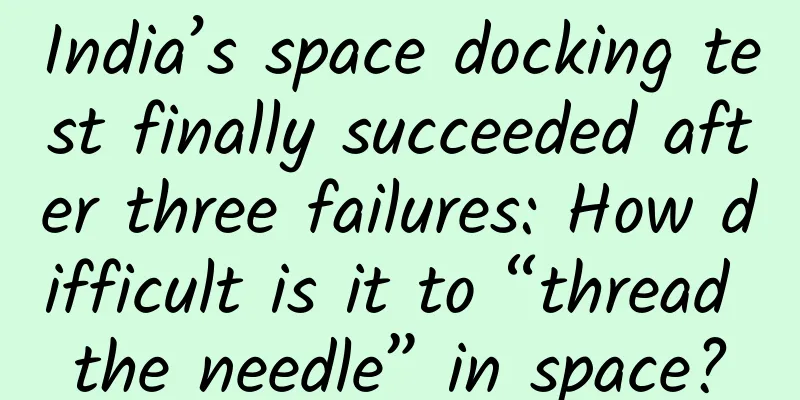India’s space docking test finally succeeded after three failures: How difficult is it to “thread the needle” in space?

|
On January 16, India's two small satellites successfully rendezvoused and docked, becoming the fourth country to achieve space rendezvous and docking, which is also a crucial step for the country to realize its dream of a space station and manned lunar landing. According to the plan, after the successful docking and locking, the two satellites will test the power transmission between them, and then separate and operate separately, with an expected lifespan of up to two years. On December 30, 2024, India launched two small satellites, Chaser and Target, for the country's first rendezvous and docking test in space. The two satellites were supposed to start their first rendezvous and docking test on January 7, 2025, in an orbit 470 kilometers high, from a distance of 20 kilometers. However, due to insufficient preparation, India’s first rendezvous and docking test was postponed on January 7. India then conducted a second test on January 9, but had to postpone it again because one of the two satellites unexpectedly deviated when the two satellites were 225 meters apart. Three days later, India conducted a third docking test, but the docking attempt was terminated again due to technical problems when the two satellites were only 3 meters apart. After many twists and turns, India's rendezvous and docking test was finally successful on January 16. This shows that space rendezvous and docking is not an easy task. Some people describe it as placing a needle in space, and then controlling a thread from the ground hundreds of kilometers away to pass through the eye of the needle, which is a "highly difficult" action. What is the purpose of space rendezvous and docking? What are the technical difficulties? Schematic diagram of the rendezvous of two Indian small satellites 01 Very versatile Space rendezvous and docking technology is very important and is a prerequisite for the normal operation of the space station. Only by mastering this technology can people and cargo be sent to the space station via spacecraft or space shuttles. However, this technology is very complex and previously only the United States, Russia and China have independently mastered it. Now, through this mission, India has become the fourth country in the world to independently master space docking technology. Space rendezvous and docking refers to the mechanical connection of two spacecraft into a whole after they meet at a predetermined position and time in the space orbit. It currently has the following two main uses: First, it provides personnel transportation and material supply services for long-term space facilities, such as space stations . Although the space station has a series of advantages such as large size, long life and strong functions, it cannot travel back and forth between the earth and the sky after it is launched into space. It is necessary to use spacecraft and other earth-to-earth transport vehicles to rendezvous and dock with the space station to send people and goods to the space station or bring them back to the ground from the space station. Schematic diagram of the in-orbit rendezvous between the Shenzhou and Tiangong space stations Second, assembling large spacecraft structures in orbit . Due to the limited capacity of current launch vehicles, it is impossible to transport hundreds of tons of spacecraft to the Earth orbit at once, so the space rendezvous and docking method is adopted, that is, the spacecraft to be built is divided into several parts and launched into an orbit at a certain altitude one after another, and then connected into a combined whole through rendezvous and docking technology. Space rendezvous and docking can also be used to enable two spacecraft to support each other in space and to reconfigure spacecraft to achieve system optimization, etc. 02 Two control methods At present, there are two main ways for spacecraft to conduct space rendezvous and docking: one is automatic control and the other is manual control . They each have their own advantages. When the distance between two spacecraft is far, ground remote control or automatic control is generally used; when the distance is close, both automatic control and manual control can be used for rendezvous and docking. Schematic diagram of the automatic rendezvous between the European "Automated Transfer Vehicle" cargo spacecraft and the "International Space Station" The advantages of using automatic control are that it is more convenient and efficient; its disadvantages are that the equipment is complex, the flexibility is poor, and it cannot handle emergencies in a timely manner, which occasionally leads to rendezvous and docking failures. Russia mainly uses this method. The advantage of manual control is that it is highly reliable, and astronauts can take timely measures to solve problems when rendezvous and docking occur; the disadvantage is that the astronauts' labor intensity is very high and is affected by the space environment. The United States mainly uses this method. Shenzhou 9 astronauts Jing Haipeng and Liu Wang conduct manual rendezvous and docking training In addition, manual rendezvous and docking places high demands on astronauts, requiring them to accurately judge the relative speed and attitude of the two spacecraft and make continuous adjustments through precise control handles. In addition, since astronauts are also faced with fuel consumption and time constraints, they must complete the docking within a certain period of time, which is also a test of their psychological quality. The weightless environment will also cause uncomfortable physiological reactions to astronauts during manual rendezvous and docking, which will affect the quality of manual rendezvous and docking operations. In 2012, astronaut Liu Wang manually controlled the Shenzhou 9 spacecraft and successfully achieved my country's first manual rendezvous and docking with the Tiangong 1 target spacecraft. As the quality of equipment used for rendezvous and docking becomes increasingly stable, space rendezvous and docking is currently mainly based on automatic control, supplemented by manual control. When automatic control fails, manual control is used instead. This can improve the economy and reliability of rendezvous and docking. Therefore, we should fully master both manual and automatic docking methods, which can back up each other and add an important "safety valve" for the successful docking between spacecraft. Our astronauts have mastered these two control methods. When our manned spacecraft conduct rendezvous and docking, they mainly use automatic control, supplemented by manual control. 03 Four major technical difficulties Because space rendezvous and docking technology is very complicated, nearly 20 space rendezvous and docking failures have occurred abroad, and even two spacecraft have "rear-ended" each other. In 1997, when the Russian Progress M-34 cargo spacecraft was docking with the Mir space station, the spacecraft lost control and collided with the space station, resulting in damage to the space station's spectral module and solar wing. Rendezvous and docking includes two parts: rendezvous and docking . Rendezvous refers to two or more spacecraft docking and meeting at a predetermined time and position in the space orbit; docking refers to two spacecraft contacting each other and connecting into a whole through a docking mechanism in the space orbit. Therefore, spacecraft must rendezvous before docking in space, that is, approach each other. Among the two spacecraft in space rendezvous and docking, one is called the target vehicle, which is usually a large spacecraft such as a space station. It serves as the target to be docked and maintains a stable operating state during rendezvous and docking. The other is called the tracking vehicle, which is usually a spacecraft or space shuttle launched from the ground. During rendezvous and docking, it has to change its orbit to catch up with the target vehicle and achieve rendezvous and docking between the two. There are four main difficulties in space rendezvous and docking technology: One of the difficulties is the extremely high speed . The two spacecraft to be docked have a speed of 28,000 kilometers per hour. If they are not controlled well, it will be very dangerous and they may easily collide or "brush past" or "miss each other." Schematic diagram of rendezvous and docking orbit The second difficulty is to rendezvous while orbiting the earth . When achieving a space rendezvous, the two spacecraft to be docked must orbit the earth while shortening their distance. Both spacecraft are flying in three-dimensional space. When one spacecraft flies to another spacecraft, they must fly along their respective orbits. To shorten the distance between the two spacecraft, they cannot accelerate like on the ground, otherwise they will leave their original orbits. Therefore, the tracking spacecraft is usually launched into an orbit slightly lower than the target spacecraft, and then gradually catches up with the target spacecraft after multiple orbit adjustments. The third difficulty is to have ultra-high precision measurement and control equipment . Only by accurately measuring and calculating the orbits, distances and speeds of the two docking parties can the two spacecraft run on the same orbit. In addition, the two spacecraft must precisely control their attitudes during docking so that the center axes of the docking surfaces of the two spacecraft are on the same docking axis. Finally, the two spacecraft are required to have a relative speed close to zero when approaching each other, and there must be no violent collision. When the two spacecraft are about to dock, the lateral error must be less than 18 cm, the attitude error must be less than 5°, and the relative speed must be less than 0.2 m/s. The fourth difficulty is the need to develop a complex, sophisticated and reliable docking mechanism. 04 Two important types of equipment To achieve space rendezvous and docking of two spacecraft, two important equipments are mainly relied on, namely, the measuring device for rendezvous and the docking mechanism for docking. If two spacecraft want to rendezvous in space, they mainly rely on the rendezvous measurement device on the spacecraft, which is the "eye" for the rendezvous and approach between the spacecraft. There are currently four main measurement devices: 01 The first is microwave radar, which has a measurement range from 100 km to 100 meters relative distance, and the error is large when the distance is less than 100 meters; 02 The second is laser radar, which has a measurement range from 20 kilometers to 10 meters relative distance and has a relatively high measurement accuracy; 03 The third is the optical imaging sensor, which has a measurement range from 100 to 1 meter relative distance and has higher measurement accuracy; 04 The fourth is the docking sensor, whose measurement range is from 10 to 0 meters relative distance. In addition, the global satellite navigation positioning system is also widely used. The front of the space station core module photographed by the spacecraft Therefore, when the two spacecraft are far apart, microwave radar, laser radar, and satellite navigation and positioning receivers are used; when they are close, optical imaging sensors and docking sensors are used. In addition, the rendezvous measurement equipment should be backed up in each flight phase to prevent the rendezvous and docking failure caused by sudden failure of the rendezvous measurement equipment. If two spacecraft want to dock in space, they must rely on the docking mechanism on the spacecraft. There are two main types of docking mechanisms currently used: The first is the "rod-cone" docking mechanism, which has the advantages of simple structure and light weight; the disadvantage is that the docking mechanism is completely installed inside the spacecraft shell, which occupies a large internal space after docking and has a relatively low carrying capacity. At present, the docking of Russia's "Soyuz" series manned spacecraft and "Progress" series cargo spacecraft with the "International Space Station" all adopts the "rod-cone" docking mechanism. The Russian Progress MM cargo spacecraft extends its docking rod to prepare for docking After the Russian spacecraft docked with the Russian module of the International Space Station, the rod-cone docking mechanism occupied the passage near the hatch, so they needed to be removed. The second is the "heterogeneous body with the same structure around" docking mechanism, which has the advantage that the channel is unobstructed after docking. Since the docking connection ring has a large diameter and a large load-bearing capacity, it is suitable for docking between spacecraft of various masses. The disadvantage is that the structure is relatively complex and the mass is large. At present, the docking between the US Crew Dragon and the International Space Station, my country's Shenzhou manned spacecraft, and Tianzhou cargo spacecraft and the Tiangong space station all use a "heterogeneous same-structure peripheral" docking mechanism. my country's "heterogeneous structure and peripheral" docking mechanism India's "heterogeneous and homogeneous peripheral" docking mechanism 05 Two docking modes There are existing standard docking modes and rapid docking modes for space rendezvous and docking between spacecraft. The standard docking mode is roughly divided into the following four stages: Ground guidance phase When the two spacecraft are 10,000 to 100 kilometers apart, the tracking vehicle must, under the control of the ground control center, perform several orbit change maneuvers to enter the range where the rendezvous measurement equipment on the tracking vehicle can capture the target vehicle. Schematic diagram of the tracking aircraft changing its trajectory to catch up with the target aircraft Automatic homing stage When the two space vehicles are 100 kilometers to 100 meters apart, the tracking vehicle will automatically guide itself to the vicinity of the target vehicle through the rendezvous measurement equipment carried by both parties and enter the docking corridor. Final Approach When the two spacecraft are 100 to 1 meter apart, the tracking vehicle uses a measurement system to accurately measure the distance, relative speed and attitude of the two vehicles, and at the same time starts a small engine to maneuver it along the docking corridor to make the final approach to the target. At this time, the relative speed of the two spacecraft is about 3 to 1 meter per second. Butt joint stage When the two spacecraft are within 1 meter of each other, they must be aligned axially, the tracking spacecraft shuts down its engine, sends a docking signal, and extends its docking mechanism. The target spacecraft opens the collision lock, and the tracking spacecraft contacts the target at a docking speed of 0.2 meters per second, achieving a hard connection in structure, including pipes, power supplies, and communication line connections. Some foreign cargo spacecraft use the "docking" method for docking, that is, when the spacecraft and the space station are close to 10 meters away, the relative speed between the two is close to zero, and then the robotic arm on the space station captures it and docks with the space station. This docking method can reduce the mass, cost and complexity of the docking system on the spacecraft. The Japanese cargo spacecraft uses American technology to dock with the International Space Station through the robotic arm on the space station. In the standard docking mode, the tracking vehicle needs to fly for about 2 days before it can dock with the target vehicle. In recent years, China, Russia and other countries have begun to use the rapid docking mode in their manned space activities, and the spacecraft only needs to fly for 6.5 hours or less to dock with the space station. The key to achieving rapid rendezvous and docking is to transfer the work of the original long-distance guidance segment that required ground intervention to the autonomous operation of the on-board computers of the two spacecraft. That is, to change the original "ground-based remote guidance segment" to "autonomous". Based on the satellite navigation system providing real-time position information of the spacecraft and the space station, the spacecraft's on-board computer can autonomously determine the orbit and calculate the orbit change data, and then control the orbit control engine to perform autonomous orbit change, thus realizing long-distance, fully autonomous navigation calculation and guidance control. The actions after the remote guidance phase are exactly the same as those of previous docking missions. The 6.5-hour rapid rendezvous and docking only requires four orbits around the earth, with two orbit changes in each of the first three orbits. In the past, using the standard docking mode, the spacecraft had to orbit the earth more than 30 times before docking with the target spacecraft. It is reported that the space rendezvous and docking solution adopted by India mainly relies on the satellite positioning system based on the differential global navigation satellite system. 06 China Rendezvous and Docking At present, my country's space rendezvous and docking technology is relatively mature. It has not only mastered the automatic and manual rendezvous and docking technology, as well as the rapid rendezvous and docking technology. Among them, the Tianzhou-5 cargo spacecraft created the world's fastest rendezvous and docking record for a space station, successfully docking with the "Tiangong" space station after only two hours of flight. It has also mastered the radial autonomous rendezvous and docking technology. The so-called radial docking is that the manned spacecraft rendezvous and docks with the space station through the docking interface under the "Tianhe" core module of the space station. Although the direction has only changed by 90°, the difficulty of docking has increased a lot. The entire process of radial rendezvous and docking in my country is completed intelligently and autonomously by the spacecraft under the command of the guidance, navigation and control system. Schematic diagram of radial rendezvous between Shenzhou 13 (below) and the core module's node module In order to adapt to the new requirements of multiple interfaces and rapid rendezvous and docking in space station operations, China has added a new flight feature point for the rendezvous and docking mission during the space station stage - the central aiming point . It is the "transit station" before the rendezvous and docking of manned spacecraft, cargo spacecraft and space station. It is located at the rear and lower part of the space station. Through this point, rendezvous and docking with the forward, radial and rearward docking interfaces of the space station can be completed most conveniently and quickly, saving time (time) and effort (propellant consumption). When my country completed the Chang'e-5 mission, it carried out the world's first unmanned rendezvous and docking in lunar orbit. That is, after the Chang'e-5 lander-ascender combination completed the lunar surface sampling, the ascender would take off from the lunar surface carrying the lunar samples and head to the lunar orbit, where it would rendezvous and dock with the orbiter-returner combination flying in the lunar orbit, and then transfer the lunar samples from the ascender to the returner. Rendezvous and docking in lunar orbit is different from rendezvous and docking in Earth orbit. China has relatively mature experience in spacecraft rendezvous and docking in Earth orbit, and has repeatedly adopted the "small chasing big" mode, that is, a small-mass spacecraft chasing the large-mass "Tiangong". However, rendezvous and docking in lunar orbit requires the "big chasing the small", that is, using a large-mass orbiter-returner combination with more fuel to chase a small-mass ascender. Moreover, the distance from the earth is hundreds of thousands of kilometers, and any slight miscontrol will result in deviation, so the rendezvous and docking requires higher accuracy. Schematic diagram of the rendezvous and docking of the ascender and the orbiter-returner combination in the lunar orbit (Source: China Academy of Space Technology) In addition, in order to prevent the large-mass orbiter-returner combination from knocking away the small-mass ascender during docking, they adopted a docking and capture rendezvous and docking method during lunar orbit rendezvous and docking. Therefore, a space light and small weak-impact docking mechanism called a claw-type was developed and installed on the orbiter. During docking, it first "embraces" the ascender and then docks with the ascender. These design concepts are world firsts. The success of these technologies has also laid the foundation for my country to carry out manned rendezvous and docking in lunar orbit when it implements manned lunar landing before 2030. Author: Pang Zhihao Chief Scientific Communication Expert of National Space Exploration Technology Editor: Dong Xiaoxian Reviewer: Zhang Chao, Li Peiyuan |
<<: Orange cats are fat and silly? This may be because there are more male orange cats
>>: It’s hard to imagine that the principles of perming hair and steaming buns are the same?
Recommend
No idea for event operation? Maybe you should read this article...
As an employee of the company, it is more accurat...
Are parasites reliable as drug "couriers"? | Ficus microcarpa
Hello, I am Rong Ge from the China Science and Te...
8 App Rapid Development Tools That Developers Must Know
"I have a great idea, all I need is a CTO......
New progress in the study of "Black Widow" pulsars: a beacon in the universe? Or a bloodthirsty killer?
You may know the beautiful and cold "Black W...
Is there really a lottery formula? He won the lottery jackpot 14 times in his life, and the lottery rules of many countries have changed because of him
Lottery had already appeared in ancient Rome 2,00...
Science in this week's hot topics: Playing with your phone for 8 minutes before bed can make you excited for more than an hour
2022, Week 9, Issue 7, Total Issue 23 I wanted to...
How shared bikes make profit from "impossible" to "possible"
In two articles I wrote recently, I talked about ...
Three-cycle trading system stock application course
Course Catalog Section 1 Three-cycle stock select...
FDD 4G commercial trial: What do China Telecom, China Unicom and China Mobile think?
At the Tianyi Mobile Phone Trade Fair, when China ...
Why are vaccines never given in the buttocks? Why are they only given in the arm, which is super painful?
inject That may be everyone's childhood shado...
LG officially announces its exit from smartphone business
LG said in a regulatory filing that its mobile co...
After Douyin’s fan base exceeded 100 million, I have some thoughts on short videos
As the new media director of Fan Deng Reading, I ...
An aircraft that can swim - the amphibious aircraft "Kunlong"
Science Fiction Network, November 30 (Xu Mingyang...
Toyota Motor Financial Report: Net profit in Q2 of fiscal year 2024 fell 55% year-on-year
Toyota Motor released its financial report for th...
Indonesia is so rich that it can do whatever it wants? It purchases foreign weapons on a large scale and continues to develop a sci-fi "three-body stealth speedboat"
Indonesia has approved a $125 billion budget to m...









